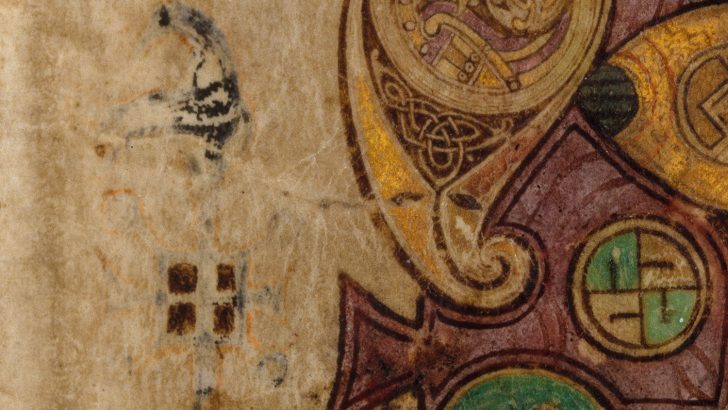An online exhibition highlighting the histories of the unique and rare collections of the library of Trinity College Dublin is available online and represents 3,000 years of “creativity, memory and knowledge”.
The Library of Trinity College Dublin dates back to the establishment of the college in 1592 and is the largest library in Ireland. Its extensive collection of journals, manuscripts, maps and music reflects over 400 years of academic development and amounts to over six million volumes.
Success
Building on the success of the Director’s Choice: The Library of Trinity College Dublin, published this year by Scala Arts & Heritage Publishers, the new expanded digital platform Director’s Choice Uncut features more of the library’s treasures.
A Legal Deposit Library since 1801, it receives copies of all material published in the UK and Ireland. Of course, the most famous of its treasures is the Book of Kells – one of the finest examples of medieval art.
The Book of Kells is featured in the exhibition with a fascinating insight into how technology has helped uncover more elements hidden on its pages.
The exhibition page states: “The 9th-century gospel does not always readily yield up its secrets. This summary of the gospel announcing the birth of Christ is an exuberant combination of colour, sinuous letterforms, human figures, peacocks and snakes. A later reader transcribed the display script at the foot of the page: NATIUITAS / CHRISTI IN BETHLEM IU/DEAE MAGI / MUNERA OFFERUNT ET / INFANTES INTER/FICIUNTUR REGRESSIO (‘The birth of Christ in Bethlehem of Judea. The wise men offer gifts and the children are killed…’).
“The small, seemingly stray detail in the lower left margin of the page [pictured below], standing alone like a medieval afterthought outside of the framed proclamation of the birth of Christ, went unnoticed in scholarly analysis of this page. Then along came technology: the digitisation of the Book of Kells in 2013 changed the way that it could be studied. Where once one could barely discern the base and stem of a blurred object, now the arms and red outline of a processional cross topped with a bird, probably an eagle, came into focus when magnified at high resolution. The red flared tail at the base suggests that this was a cross that could be carried in procession or slotted into a base to stand on the altar. This minor detail, long overlooked, may represent a cross that once stood in the monastery where the Book of Kells was created.”
The exhibition also includes the Book of Leinster (Leabhar Laighean), which has a claim to be the most important of the 12th-century manuscripts held in the Library of Trinity College Dublin.
The ‘prime historian of Leinster’ Áed Úa Crimthainn, abbot of Terryglass, County Tipperary, wrote the text during a period of huge ecclesiastical reform and political turmoil in Ireland. The Book of Leinster is an anthology of early Irish sagas, genealogy, medical knowledge, place-name lore and the study of grammar.
In the online exhibition, regarding the Book of Leinster, it states: “Most famously, it contains the Irish ‘Book of Genesis’ (Lebor Gabála Érenn), which establishes the place of Ireland, the Irish people and their language in a Biblical world setting. The Irish language, according to this book, was created after the confusion at the Tower of Babel. It claims that Irish avoided all the ‘shortcomings’ and ‘confusion’ found in the other languages and was thus deserving of special recognition. This origin legend was particularly relevant in medieval times when Irish was threatened by the enormous prestige of Latin.”
The Library also bears testament to more recent history, counting letters from Irish WWI soldiers and various artefacts from the Easter Rising – including a bullet fired through the Library roof – among its collection. This selection of objects highlights the diversity of the holdings and illuminates their history.
New digital platform
Librarian and College Archivist, Helen Shenton said: “We are delighted to be able to share some of the extraordinary items that form part of our magnificent collections through this expanded new digital platform Director’s Choice Uncut.
“Taking inspiration from the success of the book Director’s Choice: The Library of Trinity College Dublin published earlier this year… we decided to further expand the selection of items. These diverse riches represent 3,000 years of creativity, memory and knowledge. We hope you connect with, and are inspired by, these objects…”
Ranging from the iconic to the less well known, Ms Shenton has selected some of the collections’ precious items. She is joined by her library staff in telling the stories of each object, which range from the historic to the contemporary.
The selection ranges from 3,000-year-old papyrus scrolls of Egyptian Books of the Dead to Samuel Beckett’s minimalist postcards sent from France to his friends; from Dean Jonathan Swift’s death mask to the elegantly hand-written drafts of John Banville’s novel; from one of Trinity’s most celebrated alumni, Oscar Wilde’s witty trade cards to John Millington Synge’s typewriter; from the Nuremberg Chronicle of 1493, the most famous woodcut-illustrated book in the western world to the marriage certificate of James III; from the Book of Durrow , a hundred years older than the Book of Kells, to correspondence between Michael Collins and Winston Churchill, so revealing of their respective personalities; from Michael Davitt’s Diary to In Fairyland pictures from the elf-world from the Pollard Collection of children’s books. There definitely seems to be something for everyone’s tastes.
The exhibition can be viewed online using this link: https://www.tcd.ie/library/exhibitions/directors-choice/


 Chai Brady
Chai Brady The Book of Kells
The Book of Kells 